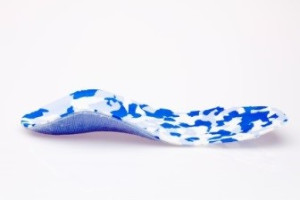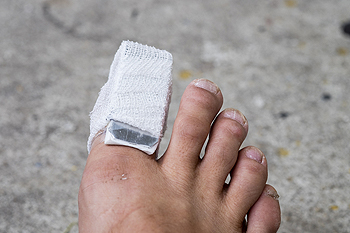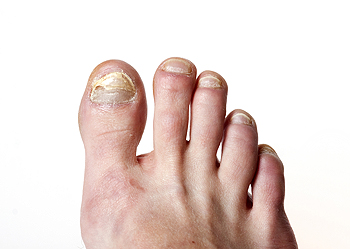Connect With Us
Blog
Three Types of Orthotics
 Orthotics are devices that are worn in the shoes which may help to correct foot structure. These are generally designed by a podiatrist who can determine the reason why wearing orthotics can be beneficial. Research has noted that there are three types of orthotics to choose from. People who participate in sporting activities that include jumping may benefit from wearing soft orthotics, as this may help to increase cushioning. Patients who have flat feet may find that wearing semi-rigid orthotics can help to provide the stability that is needed to accomplish daily activities. Wearing rigid orthotics may be beneficial in diminishing pain that can be present in patients who have neurological illnesses. If you have pain in your feet, it is advised that you consult with a podiatrist who can determine if wearing orthotics is right for you.
Orthotics are devices that are worn in the shoes which may help to correct foot structure. These are generally designed by a podiatrist who can determine the reason why wearing orthotics can be beneficial. Research has noted that there are three types of orthotics to choose from. People who participate in sporting activities that include jumping may benefit from wearing soft orthotics, as this may help to increase cushioning. Patients who have flat feet may find that wearing semi-rigid orthotics can help to provide the stability that is needed to accomplish daily activities. Wearing rigid orthotics may be beneficial in diminishing pain that can be present in patients who have neurological illnesses. If you have pain in your feet, it is advised that you consult with a podiatrist who can determine if wearing orthotics is right for you.
If you are having discomfort in your feet and would like to try orthotics, contact one of our podiatrists from Foot & Ankle Associates of Maine. Our doctors can provide the care you need to keep you pain-free and on your feet.
What Are Orthotics?
Orthotics are inserts you can place into your shoes to help with a variety of foot problems such as flat feet or foot pain. Orthotics provide relief and comfort for minor foot and heel pain but can’t correct serious biomechanical problems in your feet.
Over-the-Counter Inserts
Orthotics come in a wide variety of over-the-counter inserts that are used to treat foot pain, heel pain, and minor problems. For example, arch supports can be inserted into your shoes to help correct overarched or flat feet, while gel insoles are often used because they provide comfort and relief from foot and heel pain by alleviating pressure.
Prescription Orthotics
If over-the-counter inserts don’t work for you or if you have a more severe foot concern, it is possible to have your podiatrist prescribe custom orthotics. These high-quality inserts are designed to treat problems such as abnormal motion, plantar fasciitis, and severe forms of heel pain. They can even be used to help patients suffering from diabetes by treating foot ulcers and painful calluses and are usually molded to your feet individually, which allows them to provide full support and comfort.
If you are experiencing minor to severe foot or heel pain, it’s recommended to speak with your podiatrist about the possibilities of using orthotics. A podiatrist can determine which type of orthotic is right for you and allow you to take the first steps towards being pain-free.
If you have any questions please contact our office located in Brunswick, ME . We offer the newest diagnostic and treatment technologies for all your foot and ankle needs.
Have I Broken My Toe?
 Common causes of a broken toe typically include a heavy object falling on one or more of your toes, or stubbing your toe against a piece of furniture. The affected toe may look swollen, bruised, and can be difficult to walk on. If the fracture is severe, the toe may look crooked and deformed, and this may cause severe pain and discomfort. Patients who have broken toes may choose to use buddy taping as a form of treatment. This method involves taping the broken toe to an adjacent toe, and can be effective in providing the stability that is necessary as the healing process occurs. After a proper diagnosis is performed, which typically involves having an X-ray taken, treatment can begin. If you have broken your toe, it is advised that you consult with a podiatrist who can help you to effectively manage this type of fracture.
Common causes of a broken toe typically include a heavy object falling on one or more of your toes, or stubbing your toe against a piece of furniture. The affected toe may look swollen, bruised, and can be difficult to walk on. If the fracture is severe, the toe may look crooked and deformed, and this may cause severe pain and discomfort. Patients who have broken toes may choose to use buddy taping as a form of treatment. This method involves taping the broken toe to an adjacent toe, and can be effective in providing the stability that is necessary as the healing process occurs. After a proper diagnosis is performed, which typically involves having an X-ray taken, treatment can begin. If you have broken your toe, it is advised that you consult with a podiatrist who can help you to effectively manage this type of fracture.
A broken toe can be very painful and lead to complications if not properly fixed. If you have any concerns about your feet, contact one of our podiatrists from Foot & Ankle Associates of Maine. Our doctors will treat your foot and ankle needs.
What to Know About a Broken Toe
Although most people try to avoid foot trauma such as banging, stubbing, or dropping heavy objects on their feet, the unfortunate fact is that it is a common occurrence. Given the fact that toes are positioned in front of the feet, they typically sustain the brunt of such trauma. When trauma occurs to a toe, the result can be a painful break (fracture).
Symptoms of a Broken Toe
- Throbbing pain
- Swelling
- Bruising on the skin and toenail
- The inability to move the toe
- Toe appears crooked or disfigured
- Tingling or numbness in the toe
Generally, it is best to stay off of the injured toe with the affected foot elevated.
Severe toe fractures may be treated with a splint, cast, and in some cases, minor surgery. Due to its position and the pressure it endures with daily activity, future complications can occur if the big toe is not properly treated.
If you have any questions please feel free to contact our office located in Brunswick, ME . We offer the newest diagnostic and treatment technologies for all your foot and ankle needs.
Are You Suffering From Ingrown Toenails?
Fungus and Athlete’s Foot
 Athlete’s foot is a common condition that affects the bottom of the feet or in between the toes. It can be uncomfortable as a result of consistent itching, and in severe cases, blisters may form. It is caused by a fungus that typically lives and thrives in moist environments. These types of areas often include public swimming pools, shower room floors, and surrounding areas. It is considered to be contagious, and an effective prevention method may consist of wearing appropriate shoes while in these places. Some patients may find mild relief if an anti-fungal spray is applied. If you are noticing symptoms of athlete's foot, it is suggested that you speak to a podiatrist who can properly diagnosis this condition, and prescribe medication if this ailment is severe.
Athlete’s foot is a common condition that affects the bottom of the feet or in between the toes. It can be uncomfortable as a result of consistent itching, and in severe cases, blisters may form. It is caused by a fungus that typically lives and thrives in moist environments. These types of areas often include public swimming pools, shower room floors, and surrounding areas. It is considered to be contagious, and an effective prevention method may consist of wearing appropriate shoes while in these places. Some patients may find mild relief if an anti-fungal spray is applied. If you are noticing symptoms of athlete's foot, it is suggested that you speak to a podiatrist who can properly diagnosis this condition, and prescribe medication if this ailment is severe.
Athlete’s Foot
Athlete’s foot is often an uncomfortable condition to experience. Thankfully, podiatrists specialize in treating athlete’s foot and offer the best treatment options. If you have any questions about athlete’s foot, consult with one of our podiatrists from Foot & Ankle Associates of Maine. Our doctors will assess your condition and provide you with quality treatment.
What Is Athlete’s Foot?
Tinea pedis, more commonly known as athlete’s foot, is a non-serious and common fungal infection of the foot. Athlete’s foot is contagious and can be contracted by touching someone who has it or infected surfaces. The most common places contaminated by it are public showers, locker rooms, and swimming pools. Once contracted, it grows on feet that are left inside moist, dark, and warm shoes and socks.
Prevention
The most effective ways to prevent athlete’s foot include:
- Thoroughly washing and drying feet
- Avoid going barefoot in locker rooms and public showers
- Using shower shoes in public showers
- Wearing socks that allow the feet to breathe
- Changing socks and shoes frequently if you sweat a lot
Symptoms
Athlete’s foot initially occurs as a rash between the toes. However, if left undiagnosed, it can spread to the sides and bottom of the feet, toenails, and if touched by hand, the hands themselves. Symptoms include:
- Redness
- Burning
- Itching
- Scaly and peeling skin
Diagnosis and Treatment
Diagnosis is quick and easy. Skin samples will be taken and either viewed under a microscope or sent to a lab for testing. Sometimes, a podiatrist can diagnose it based on simply looking at it. Once confirmed, treatment options include oral and topical antifungal medications.
If you have any questions, please feel free to contact our office located in Brunswick, ME . We offer the newest diagnostic and treatment technologies for all your foot care needs.

